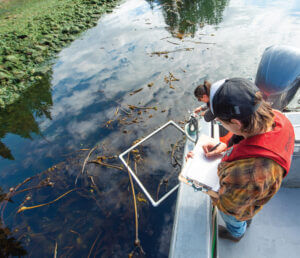Seaweed solutions
The Kwiakah First Nation’s slow, intentional approach to kelp cultivation
Fatima Aamir

Photo by North Island College
Seaweed, a traditional food for many coastal First Nations in B.C., is experiencing a renaissance, thanks to its untapped carbon sequestration potential. In recent years, multiple First Nations have partnered with private companies like Cascadia Seaweed to lead this growing industry. But unlike other coastal First Nations in B.C., the Kwiakah First Nation—a small band of 21 registered members located near Phillips Arm and Frederick Arm—has not signed production agreements with seaweed companies. That’s because conserving kelp forests, instead of making a profit from farming them, is the main factor driving the Kwiakah members’ work.
“I don’t think, if we don’t do the kelp thing right … that our coast can survive another industrial onslaught,” cautions the band’s administrator and economic development officer, Frank Voelker, describing decades of gold mining, logging, and fish farming.
The Kwiakah Nation is unique in that it does not receive as much federal funding as some other nations since it does not have a residential reservation, Voelker explains. “Over the decades, the band members just adjusted to that and became self-reliant,” he says, adding that the nation turned a “huge disadvantage” into a positive.
As a result, not only are the Kwiakah in a stronger position to say no to companies that promise jobs at the expense of the environment, but they can learn how to become better kelp farmers through smaller-scale initiatives, rather than jumping headfirst into uncertain new ventures under the pressure to generate jobs.
RESISTING PRESSURES TO SCALE UP
The Kwiakah are currently repurposing an old fish farm into a kelp farm—including establishing pre-processing facilities, where kelp would be dried before transport—and a research centre.
Despite having a good research relationship with industrial actor Cascadia Seaweed, the Kwiakah Nation has not rushed to sign any production agreements; its traditional territory in the Phillips and Frederick Arm region has long experienced serious, irreparable environmental damage from B.C.’s extraction industry.
As mentioned, one reason kelp farming has been of great interest in B.C. in recent years is due to the ability of kelp forests to sequester and store carbon. The carbon stored in coastal ecosystems is called “blue carbon” and is often touted as a way to mitigate the impacts of climate change.
But because of the Earth’s changing climate and rising ocean temperatures, carbon-sequestering species like kelp are dwindling in number without human intervention.
Given the potential of blue carbon, communities might be tempted to grow kelp in many B.C. inlets, but undertaking any such activity on a large scale has to be approached with caution, Voelker says.
This is why the Kwiakah are working closely with sister tribes within the Laich-Kwil-Tach First Nation and speaking with elders to understand traditional methods of cultivation, including learning how much kelp has historically grown in the region and working to match those quantities, not exceed them.
KELP CULTIVATION VS. KELP FARMING
Kelp farming isn’t the only way to reap the environmental benefits of kelp and generate income.
One promising solution is for the Kwiakah to participate in seaweed cultivation for its own sake, which will enrich the marine ecosystem and absorb carbon dioxide, and for which the community can be compensated through a carbon scheme.
“That would be my dream scenario,” Voelker muses, “purely carbon sequestration and [the community] getting paid for it.”